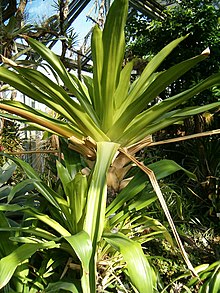Brocchinia
| Brocchinia | |
|---|---|
 |
|
| Brocchinia micrantha | |
| Scientific classification | |
| Kingdom: | Plantae |
| (unranked): | Angiosperms |
| (unranked): | Monocots |
| (unranked): | Commelinids |
| Order: | Poales |
| Family: | Bromeliaceae |
| Subfamily: | Brocchinioideae |
| Genus: |
Brocchinia J.H.Schult. ex J.A.Schult. & J.H.Schult. (1830) |
| Synonyms | |
|
Sequencia Givnish |
|
Sequencia Givnish
Brocchinia is a genus of the botanical family Bromeliaceae, subfamily Pitcairnioideae. However, a recent DNA study suggests the breakup of the Pitcairnioideae subfamily into 6 new subfamilies and Brocchinia would be the sole genus of new subfamily Brocchinioideae (family Bromeliaceae). The genus is named for Giovanni Battista Brocchi, Italian naturalist (1772–1826). Brocchinia species are native primarily to the ancient Guayana Shield in southern Venezuela and Guyana, with some species extending into Colombia and northern Brazil. Its species are generally restricted to areas of sand and sandstone of the Roraima Formation; a few occur on granite.
Based on chloroplast DNA sequence variation, Brocchinia appears to be sister to all other bromeliads. Calibration of the molecular family tree of bromeliads against the known ages of various fossil monocots suggests that Brocchinia lineage diverged from other bromeliads nearly 20 million years ago, and that some of the living species of Brocchinia began diverging from each other soon thereafter. The next lineage to diverge from other bromeliads included Lindmania and Connellia, which are also endemic to the Guayana Shield; at least one other subfamily Navioideae is also almost entirely restricted to that region. Consequently, it is quite likely that the family as a whole arose in the Guayana Shield. Previously, Brocchinia was thought to be a member of the bromeliad subfamily Pitcairnioideae, based on its possession of winged seeds like those seen in other members of that group. This view has now been overturned after the recognition that Pitcairnioideae as originally circumscribed more than a century ago represents several morphologically similar but independently derived groups that share only ancestral (plesiomorphic) characters, not true synapomorphies (shared derived characters).
...
Wikipedia
